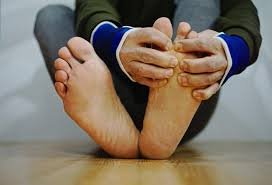
The Importance of Diabetic Foot Care
Diabetes can affect many parts of the body, and one of the most common complications is foot problems. Proper diabetic foot care is crucial in preventing severe issues such as infections, ulcers, and even amputations. The high blood sugar levels associated with diabetes can impair circulation and nerve function, making the feet more vulnerable to injury and infection. Here’s why diabetic foot care is so important and how to take care of your feet effectively.

Why Diabetic Foot Care is Essential
1. Nerve Damage (Neuropathy)
One of the most common complications of diabetes is diabetic neuropathy, which is nerve damage caused by high blood sugar. This condition reduces sensation in the feet, meaning you may not feel cuts, blisters, or other injuries. Without feeling pain, it becomes easier to overlook small injuries, which can lead to serious infections if left untreated.
2. Poor Circulation
Diabetes can also lead to poor circulation, particularly in the lower extremities. When blood flow to the feet is limited, it can slow down the healing process and make it harder for the body to fight infections. This poor circulation can also lead to tissue damage, making it easier for wounds to become infected.
3. Increased Risk of Infection
With nerve damage and poor circulation, minor foot issues such as blisters or cuts can quickly become severe infections. These infections may not heal as easily due to limited blood flow, which can lead to more serious complications, including ulcers or even the need for amputations.
Tips for Proper Diabetic Foot Care
1. Inspect Your Feet Daily
One of the best ways to prevent diabetic foot complications is to regularly inspect your feet for any cuts, blisters, redness, swelling, or other signs of infection. Use a mirror if necessary to check the bottoms of your feet. If you notice anything unusual, contact your healthcare provider immediately.
2. Keep Your Feet Clean and Dry
Wash your feet daily with lukewarm water and mild soap. Avoid using hot water, as it can dry out your skin. After washing, make sure to dry your feet thoroughly, especially between the toes, as moisture can promote fungal infections.
3. Moisturize Your Feet
Diabetes can lead to dry skin, which may crack and lead to infections. Use a mild moisturizer to keep your skin soft and hydrated. However, avoid applying moisturizer between the toes, as excess moisture can lead to fungal infections.
4. Trim Your Toenails Carefully
Trim your toenails straight across to avoid ingrown toenails, which can cause pain and lead to infection. Don’t cut them too short, and be cautious when trimming to avoid nicking the skin. If you have trouble trimming your nails, consult a podiatrist for assistance.
5. Wear Proper Footwear
Diabetes can cause changes in the shape of the feet, making it important to wear shoes that fit well and provide support. Avoid tight shoes or high heels that can cause blisters or foot deformities. Also, consider wearing diabetic socks that are designed to prevent friction and improve circulation.
6. Avoid Walking Barefoot
Walking barefoot, even indoors, increases the risk of cuts, punctures, or infections. Always wear shoes or slippers to protect your feet from injury.
7. Manage Your Blood Sugar Levels
Controlling your blood sugar levels is essential for overall health, including foot health. Consistently high blood sugar levels can increase the risk of complications, so it’s important to work with your healthcare provider to keep your diabetes under control.
8. See a Podiatrist Regularly
If you have diabetes, regular visits to a podiatrist are essential. A podiatrist specializes in foot care and can help with any issues you may not notice or be able to address on your own. They can also assist with nail care, calluses, and any foot deformities.
Signs That Require Immediate Medical Attention
If you notice any of the following signs, seek medical attention right away:
- Open sores, cuts, or blisters that don’t heal
- Severe pain or swelling in the feet
- Redness or warmth around a wound
- Foul-smelling discharge from a wound
- Numbness or tingling sensations
- Fever, which can indicate an infection
Conclusion
Diabetic foot care is a critical part of managing diabetes and preventing complications. By taking simple but effective steps such as daily foot inspections, proper hygiene, wearing suitable footwear, and managing your blood sugar, you can significantly reduce your risk of foot problems. Regular visits to a podiatrist and immediate attention to any concerns will also help ensure the health and safety of your feet.







